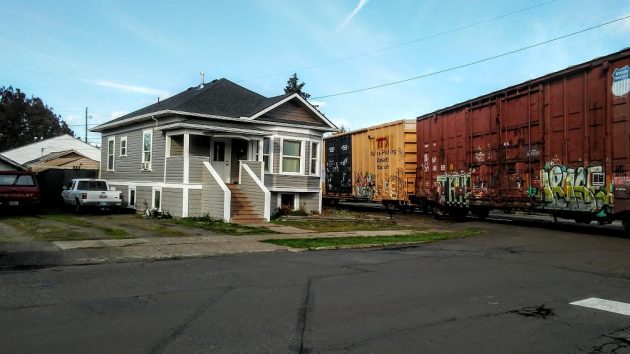
A Portland & Western freight creeps across Sixth Avenue on Oct. 14.
On a leisurely bike ride through old Albany the other day, I noticed something that wasn’t there. Where the Portland & Western Railroad crosses Sixth Avenue, there are no warning lights, bells or arms that come down when a train comes through.
This seems noteworthy because there are full sets of crossing protections– lights, bells and crossing arms — where the same track crosses the other numbered streets, from Second Avenue to Fifth.
How come there are no arms or lights or bells at Sixth? Albany’s city transportation expert, Ron Irish, thinks it may have to do with various criteria — including traffic volume and train speed — and the way crossing protections used to be paid for with federal money routed through the state, a funding stream that has dried up.
Now, he says, ODOT-Rail can require crossing protection in connection with land developments, and there there have been none that would affect the crossing at Sixth.
This crossing is on one of the curved arms of the wye that connects the Toledo Branch (the track that heads through Corvallis and Philomath) with the Union Pacific line in Albany. The curve is close to the entrance to the Albany yard, and the trains coming around that way are very slow, not much faster than a brisk walk.
This you can see below, in the few seconds of video taken on Oct. 14 before the train stopped.

I don’t remember the details, but it must have been that a load had shifted. The track, though close to the building, is not close enough for trains to routinely endanger the house.
That house, at 739 Sixth Ave. S.E., has recently been refurbished, as you can see. It forms the southeastern corner of the Hackleman Historic District. For the exterior improvements the Corvallis real estate firm that owns it had to get the OK of the Albany Landmarks Commission, and they got it on June 3.
After I stopped the bike on Sixth to watch the PNWR train come to a slow stop, I rode one block north along the narrow sidewalk between the house and the track. I wanted to confirm that the usual crossing protections are in place at Fifth. And as you can see below, they are. (hh)


I learned a new word today: wye
Thank you for that. Interesting post.
Staring from all available angles in Bing and Google street-views, I find it hard to believe that anything short of derailment could have touched the house, or the wooden sideyard fence not visible above. Maybe something leaned outward from an open boxcar door?
Come to think of it, it might have been a derailment. Sad how one’s memory fades with passing years.
Crossing arms should not be needed at any crossing if people obey the simple railroad crossing rule of “Stop”, “Look” and “Listen”.
I agree they “shouldn’t” be needed.
BUT- People have gotten used to them and I’m sure they distract people from their cell phones at times so they avoid crashing into the train. That’s the state of devolution our society has attained.
Having an oddball without arms doesn’t make sense though. Do them all the same whatever that may be.
There was a derailment there about 5 years ago that did cause some damage to the house. The IOOF Hall was thankful that their building wasn’t affected by the accident.
August 1, 2004 according to this-
https://www.ble-t.org/pr/news/headline.asp?id=11195
That accident was not the one I mentioned. The railroad has had several derailments involving inbound trains but none (in my memory) hit the house. The one that hit the house and car was an outbound train that was literally pulled off the rails. I was a witness to it, by the way.
I guess a lack of “proper warning devices” puts the obligation of watching out on the driver of the car approaching the crossing. Keep in mind, we car drivers are crossing the “private property” of the R/R.
The railroad had a ‘stringline’ accident that caused the cars to be pulled off the rail, tipping the cars over into that house. The cars also crushed the homeowners minvan. That happened about 10 years ago.
Also note that the other leg of the wye that crosses Madison Street very close to where 6th intersects does not have crossing gates, Hasso. That leg of the wye has (or had) very little traffic.
Have there been any accidents? It seems most of the people traveling that road routinely are aware of the potential. And, anyone unfamiliar is probably going to be taking extra care as they don’t know where they’re going and what obstacles may lie ahead. Proposing that expensive and unnecessary crossing arms and lights (which are also quite noisy and would already add to the disruption made by the train itself) isn’t the right approach. If it hasn’t been an issue – why turn it into one? I can see if there had been a series of near misses or accidents – but aside from some strange incident 30 years ago it sounds like it’s a well-established crossing with an effective stop sign.
Good points. I wasn’t advocating for more crossing protection. I was wondering why there wasn’t any, considering that all the other streets on that track had the full treatment.
That crossing has several railroad crossing signs. Signs before the crossing, on the pavement and the cross bucks at the tracks. People stop at stop signs at streets and roads with fewer or no advanced warning signs.